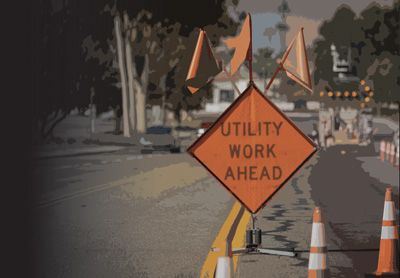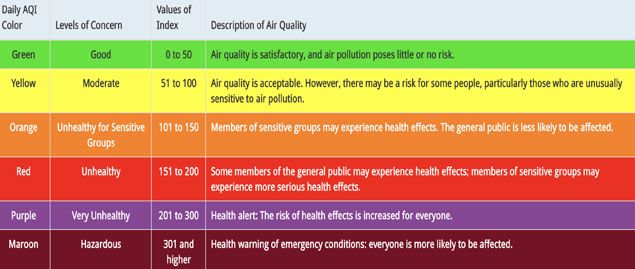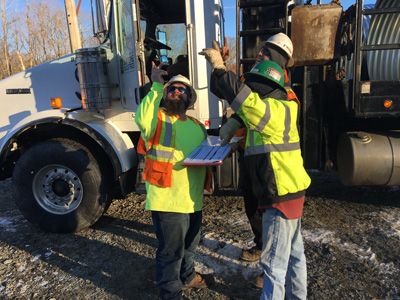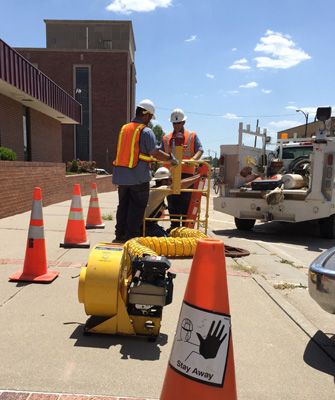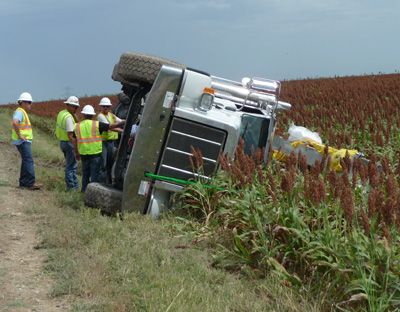Tag: Tailgate Topics
Simplifying Tasks to Improve Worker Safety
Written by Jeffrey Sullivan on . Posted in Tailgate Topics.
Powered Industrial Truck Safety
Written by Charles Keeling, CUSP on . Posted in Tailgate Topics.
4 Questions for Continuous Improvement
Written by Jesse Hardy, CSP, CIT, CUSP on . Posted in Tailgate Topics.
Chainsaw Safety Practices for Rights-of-Way
Written by Luis Ortega, CUSP Emeritus on . Posted in Tailgate Topics.
If I Could Do It All Over Again
Written by Terry Ehli on . Posted in Tailgate Topics.
The Rule of Should
Written by Rayford “RL” Grubbs, CUSP on . Posted in Tailgate Topics.
Plan on Going Home Tonight
Written by Lidia Dilley Jacobson on . Posted in Tailgate Topics.
Creating Good Safety Habits
Written by Luis Ortega, CUSP Emeritus on . Posted in Tailgate Topics.
Strategies to Handle Workplace Conflict
Written by Jesse Hardy, CSP, CIT, CUSP on . Posted in Tailgate Topics.
Getting Shocked on a Structure?
Written by Jim Vaughn, CUSP on . Posted in Tailgate Topics.
Avoid Injury When Lifting and Moving Objects
Written by Jesse Hardy, CSP, CIT, CUSP on . Posted in Tailgate Topics.
Powerful Safety Messages: Spoken and Silent
Written by Patricia Fischer, CSP, CUSA on . Posted in Tailgate Topics.
Battling Invisible Distractions
Written by Jeffrey Sullivan on . Posted in Tailgate Topics.
The End of the Day
Written by Bob Dunderdale, CUSP on . Posted in Tailgate Topics.
Watch Your Step
Written by Luis Ortega, CUSP Emeritus on . Posted in Tailgate Topics.
Drive Safe. Work Safe. Save Lives.
Written by Marilyn M. Velez, MPH on . Posted in Worksite Safety, Tailgate Topics.
Combating Drowsy Driving
Written by R. Neal Gracey on . Posted in Tailgate Topics.
Is Safety a Religion?
Written by Lidia Dilley Jacobson on . Posted in Tailgate Topics.
Are You Setting a Good Example?
Written by Terry Ehli on . Posted in Tailgate Topics.
Mitigating the Risk of Wildfire Smoke
Written by Thomas Arnold, CSP, CUSP on . Posted in Tailgate Topics.
How Does McDonald’s Marketing Apply to Your Lineworker Training?
Written by Jerry Havens, COSS on . Posted in Tailgate Topics.
4 Actions to Combat ‘Sheepeople Syndrome’
Written by Mack Turner, CUSP on . Posted in Tailgate Topics.
Reject Risk Acceptance
Written by Jeffrey Sullivan on . Posted in Tailgate Topics.
Situational Awareness, Mental Modeling and Developing a Coach’s Eye
Written by R. Neal Gracey on . Posted in Tailgate Topics.
Invest in Safety – You Can’t Afford Not To
Written by Bob Dunderdale, CUSP on . Posted in Tailgate Topics.
Drug and Alcohol Awareness on the Job Site
Written by Jesse Hardy, CSP, CIT, CUSP on . Posted in Tailgate Topics.
Everyone is the ‘Safety Person’
Written by Will Schnyer on . Posted in Tailgate Topics.
Work-Site Safety: Get in on the Ground Level
Written by Bob Dunderdale, CUSP on . Posted in Tailgate Topics.
Effective Two-Way Workplace Communication
Written by Seth T. Werling, CUSP on . Posted in Tailgate Topics.
Battling Fatigue on the Job Site
Written by Jesse Hardy, CSP, CIT, CUSP on . Posted in Tailgate Topics.
Stop Work Authority is Everyone’s Responsibility
Written by Richard J. Horan Jr., CSP, CUSP on . Posted in Tailgate Topics.
The Human Body: A Forgotten Air Monitor
Written by Dion Creggett, MPH, CIH, CSP on . Posted in Tailgate Topics.
Make Safety a Habit and a Skill
Written by Terry Greene, CSC on . Posted in Tailgate Topics.
The Value of Apprenticeships
Written by Tony Boyd, CUSP on . Posted in Tailgate Topics.
Building the St. Louis Arch
Written by Kelly Sparrow, J.D. on . Posted in Tailgate Topics.
Confessions of a Complacent Lineman
Written by David Spooner on . Posted in Tailgate Topics.
Using Checklists to Mitigate Error and Injury
Written by Thomas Arnold, CSP, CUSP on . Posted in Tailgate Topics.
One Key Question Every LIFE Guard Must Ask
Written by Lidia Dilley Jacobson on . Posted in Tailgate Topics.
Take Off Those Blinders: The Importance of Situational Awareness
Written by Jeffrey Sullivan on . Posted in Tailgate Topics.
Writing Utility Work and Safety Procedures
Written by Max Fuentes on . Posted in Tailgate Topics.
Remember Why Safety Rules Were Written
Written by David Spooner on . Posted in Tailgate Topics.
3 Safety Measures to Mitigate Substation Risks
Written by Ryan Stephens, AEP, and Amber Travis, GSP on . Posted in Tailgate Topics.
Training and Certifying Apprentices
Written by Tony Boyd, CUSP on . Posted in Tailgate Topics.
Addressing Allergic Reactions on the Job
Written by Dean Newkirk, CUSP on . Posted in Tailgate Topics.
Overcoming Slip, Trip and Fall Hazards on the ROW
Written by Jesse Hardy, CSP, CIT, CUSP on . Posted in Tailgate Topics.
Production, Quality, Safety and the Bermuda Triangle
Written by Kelly Sparrow, J.D. on . Posted in Tailgate Topics.
Four Things We Shouldn’t Say
Written by Lidia Dilley Jacobson on . Posted in Tailgate Topics.
Construction Workers are Occupational Athletes
Written by Richard J. Horan Jr., CSP, CUSP on . Posted in Tailgate Topics.
If You Could Talk to Your Younger Self, What Would You Say?
Written by David Spooner on . Posted in Tailgate Topics.
St. Thomas Storm Restoration: Lessons Learned
Written by Kevin Ripplinger and Will Schnyer, CUSP on . Posted in Tailgate Topics.
Coaching the Crew Chief in Safety
Written by Lidia Dilley Jacobson on . Posted in Tailgate Topics.
Into the Woods
Written by Jennifer A. Martin on . Posted in Tailgate Topics.
Overcoming the Effects of Short-Service Employees
Written by Jesse Hardy, CSP, CIT, CUSP on . Posted in Leadership Development, Tailgate Topics.
Going Into Battle
Written by Brad Brill, CHST, CSHO, CUSP on . Posted in Tailgate Topics.
Near-Miss and Good-Catch Reporting
Written by Jared Rumm, CUSP, GSP, Roger Timmons, CHST, and Kent Fogelberg, COSS on . Posted in Tailgate Topics.
Managing Stress in the Workplace
Written by Hubert Hayes, CHST, CUSP, MESH on . Posted in Tailgate Topics.
3 Safety Considerations for Cold Weather Work
Written by Jerry Havens, COSS on . Posted in Tailgate Topics.
Defensive Driving: How’s That Working for You?
Written by Tony Boyd, CUSP on . Posted in Tailgate Topics.
A Can of Soup: What We Say and How We Say It
Written by Mack Turner, CUSP on . Posted in Tailgate Topics.
Do More Rules Make Us Safer?
Written by Lidia Dilley Jacobson on . Posted in Tailgate Topics.
Safety Concerns When Working In and Around Manholes and Vaults
Written by Michael Stremel, CUSP on . Posted in Safety Management, Tailgate Topics.
The Power of a Tool and Equipment Inspection System
Written by Kelly Sparrow, J.D. on . Posted in Tailgate Topics.
Don’t Blame People for Human Error
Written by Mark J. Steinhofer, CHST, CSP, CUSP on . Posted in Tailgate Topics.
The Benefits of Near-Miss Reporting
Written by Ryan Dobbins, GSP, and Jordan Hollingsworth, CHST, CSP, CUSP on . Posted in Tailgate Topics.
Learning from Potential Serious Injuries and Fatalities
Written by Richard J. Horan Jr., CSP, CUSP on . Posted in Tailgate Topics.
What is Your Why?
Written by Brad Brill, CHST, CSHO, CUSP on . Posted in Tailgate Topics.
Safety vs. Productivity
Written by Jim Breuner on . Posted in Tailgate Topics.
Saving L.I.V.E.S. is Our Daily Responsibility
Written by Doug Hill, CUSP on . Posted in Uncategorized.
Are You an Active Communicator?
Written by Jay Brown on . Posted in Tailgate Topics.
Stepping Up to Safety
Written by Trey McLaughlin on . Posted in Uncategorized.
The Importance of Situational Awareness in the Utility Industry
Written by Kelly Sparrow, J.D. on . Posted in Uncategorized.
The JSA: A Process, Not a Form
Written by Chris McIntosh on . Posted in Uncategorized.
A Mother on the Job
Written by Kelly Sparrow, J.D. on . Posted in Uncategorized.
Hazard Awareness for Substation Workers
Written by Dion Creggett, MPH, CIH, CSP on . Posted in Uncategorized.
Recognizing Summit Fever in the Utility Industry
Written by Dave Sowers on . Posted in Uncategorized.
Effective Tick-Repellent Strategies for Field Workers
Written by Nathan Boutwell, CUSP on . Posted in Tailgate Topics.
10 Tips for Better Incident Investigations
Written by Thomas Ray, CSP, CUSP on . Posted in Safety Management, Leadership Development, Worksite Safety, Tailgate Topics.
Three-Way Communication for Utility Workers
Written by Rey Gonzalez on . Posted in Uncategorized.
Adding Value to Your Organization’s Safety Culture
Written by Richard J. Horan Jr., CSP, CUSP on . Posted in Tailgate Topics.
Properly Securing Vehicle Cargo is Serious Business
Written by Lee Marchessault, CUSP on . Posted in Uncategorized.
Do Your Employees Know When It’s Time to Stop?
Written by David Bowman on . Posted in Uncategorized.
Train the Trainer 101: Safety Cops and the Continuum of Safety
Written by Jim Vaughn, CUSP on . Posted in Safety Management, Leadership Development, Worksite Safety, Tailgate Topics.
Preventing Worker Injury and Damage to Vehicle and Equipment Doors in High Wind Conditions
Written by Gary Coleman, CHST, CSP, CUSP, OHST, STSC on . Posted in Uncategorized.
The 911 Dilemma
Written by Kelly Sparrow, J.D. on . Posted in Tailgate Topics.
Spotters: A Critical Element of Site Safety
Written by John Boley, CET, CHST, CUSP, and Jordan Hollingsworth, CHST, CSP, CUSP on . Posted in Uncategorized.
Coping With Industry Changes
Written by Michael J. Getman, CUSP, MBA on . Posted in Uncategorized.
The Safety Coaching Observation Process
Written by R. Neal Gracey on . Posted in Tailgate Topics.
Human Performance and a Rat Trap
Written by David Bowman on . Posted in Uncategorized.
Distribution Switching Safety
Written by Mike Caro, CUSP on . Posted in Uncategorized.
The Most Important Tool on the Job Site
Written by Jordan Hollingsworth, CHST, CSP, CUSP, and Joe Clady on . Posted in Uncategorized.
Thirty Years of Personal Perspective
Written by Will Schnyer on . Posted in Uncategorized.
The Power of Human Intuition
Written by Rey Gonzalez on . Posted in Tailgate Topics.
Overhead Utility Hazards: Look Up and Live
Written by Clifford Carroll, CUSP on . Posted in Tailgate Topics.
Safe By a Nose
Written by Kelly Sparrow, J.D. on . Posted in Tailgate Topics.
Human Performance Tools: Important or Critical?
Written by Richard J. Horan Jr., CSP, CUSP on . Posted in Uncategorized.
Safety and Common Sense
Written by Ron Joseph, CUSP on . Posted in Uncategorized.
Job Briefing for One
Written by Michael J. Getman, CUSP, MBA on . Posted in Tailgate Topics.
The Perils of Distracted Driving
Written by Gary Coleman, CHST, CSP, CUSP, OHST, STSC on . Posted in Tailgate Topics.
PPE: Much More Than Basic or General Protection
Written by Steve Bryant, CUSP on . Posted in Uncategorized.


